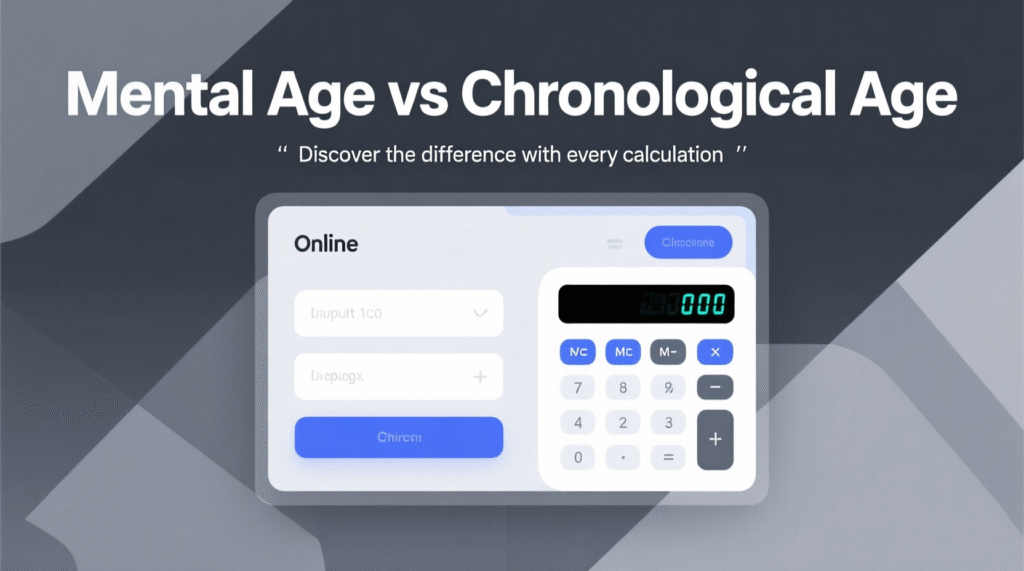
If you’re a parent, student, or educator trying to understand cognitive assessments, the terms “mental age” and “IQ test” can be confusing. They sound similar, and historically, they were linked. However, they mean very different things today. This guide clarifies the distinction, explains how each is used, and answers your most common questions.
This content is for anyone looking to understand the core differences between these two psychological concepts, whether for academic purposes, to interpret a child’s assessment results, or simply out of curiosity.
What is Mental Age?
Mental age is a concept that compares an individual’s cognitive ability to the average ability of a specific age group. It was developed by psychologist Alfred Binet in the early 1900s to identify students who needed extra help in school.
In simple terms, if a 7-year-old can answer questions that an average 9-year-old can, their mental age is considered to be 9. It’s a way of describing performance in terms of an age level. Test your accurate mental age
What is an IQ Test?
An Intelligence Quotient (IQ) test is a standardized assessment that measures a range of cognitive abilities and provides a score that compares an individual’s performance to that of a norm group of the same age.
Modern IQ tests, like the Wechsler Adult Intelligence Scale (WAIS) or the Stanford-Binet test, have moved away from the old mental age formula. Instead, they use a “deviation IQ.” Your score reflects how far your performance deviates from the average score of 100 for your specific age group.
Learn how IQ and maturity differ in is mental age the same as IQ.
Mental Age vs. IQ Test: The Key Differences Explained
The easiest way to see the difference is to compare them side-by-side.
| Feature | Mental Age | IQ Test (Modern) |
| What It Is | A measure of performance against age-group norms. | A standardized score comparing you to your peers. |
| How It’s Expressed | As an age (e.g., “a mental age of 10”). | As a numerical score (e.g., “an IQ of 115”). |
| Core Idea | “How does this person perform compared to average kids of different ages?” | “How does this person perform compared to others their own age?” |
| Primary Use Today | A descriptive concept, sometimes used in developmental psychology. | A clinical and educational assessment tool for identifying giftedness, intellectual disabilities, and learning profiles. |
Compare how intellect and experience grow together in mental age vs intellectual age.
How Are These Concepts Used in Real Life?
Understanding the practical application can help clear up the confusion.
Real-Life Example 1: Understanding a Child’s Abilities
- Parent’s Question: “My 8-year-old son’s teacher said he has the problem-solving skills of a 10-year-old. What does that mean for him?”
- Application: This is a classic application of the mental age concept. It means your son’s cognitive development in that specific area is advanced for his chronological age. This insight helps the teacher provide more challenging material to keep him engaged, rather than simply labeling him with a score.
Real-Life Example 2: Interpreting an Assessment
- Use Case: A psychologist assesses a 12-year-old for a gifted program using the WISC-V (a common IQ test).
- Result: The child receives a Full-Scale IQ score of 132.
- Interpretation: This is a deviation IQ score. It doesn’t mean the child has the mental age of a 15-year-old. Instead, it means their overall cognitive performance is two standard deviations above the average for other 12-year-olds, placing them in the top 2% of their peers. This standardized score is what the gifted program uses for admission.
Read mental age vs intellectual age to understand the deeper layers of intelligence beyond IQ.
Frequently Asked Questions (FAQ)
1. What is the old formula for IQ that used mental age?
The original “ratio IQ” formula was: IQ = (Mental Age / Chronological Age) × 100. If a 10-year-old had a mental age of 12, their IQ would be (12/10) x 100 = 120. This method is no longer used in modern testing.
2. Why don’t modern IQ tests use mental age anymore?
The mental age concept works poorly for adults. Cognitive development isn’t linear; the difference between a 35-year-old and a 40-year-old isn’t the same as between a 5-year-old and a 10-year-old. The deviation IQ provides a much more stable and accurate measure across all ages.
3. Can mental age be higher than chronological age?
Yes. This was the original basis for identifying advanced or gifted children. If a child’s mental age was significantly higher than their actual age, it indicated advanced cognitive development for their years.
4. Is a high IQ score the only sign of intelligence?
No. IQ tests measure specific cognitive abilities like reasoning, memory, and processing speed. They don’t measure creativity, emotional intelligence, or practical “street smarts.” Intelligence is a complex, multifaceted concept that a single score cannot fully capture.
5. How is an IQ score of 100 interpreted?
An IQ score of 100 is the exact average for an individual’s age group. In a deviation IQ system, the test is standardized so that the median score is 100. Scores above 100 are above average, and scores below are below average.
6. Can you increase your IQ score?
While your underlying cognitive ability is relatively stable, scores can fluctuate. Factors like education, practice with similar test questions, and even your mood on test day can influence the result. Engaging in mentally stimulating activities can improve the cognitive skills that IQ tests measure.
7. What’s the difference between the Stanford-Binet and Wechsler tests?
Both are leading IQ tests. The Stanford-Binet was the first to use the IQ concept and historically provided one overall score. The Wechsler scales (WISC for children, WAIS for adults) are known for providing scores across different domains (e.g., Verbal Comprehension, Perceptual Reasoning), which can be useful for identifying specific cognitive strengths and weaknesses.
